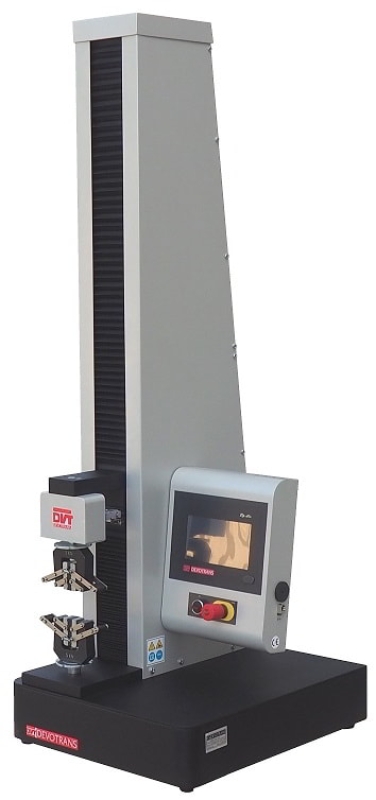TENSILE COMPRESSION TEST MACHINE DVT BP D NN DVT BP D NN
Single-column model used for capacities up to 3 kN.
INDUSTRIAL SECTORS OF USE
TECHINAL INFORMATION
- Stopping, depending on the Breakout/Fracture or distance.
- Maintenance-free, solid and reliable structure.
- Colour touch screen.
- Rapid return to the starting point.
- Emergency stop button.
- 2-column and single-screw system, monoblock.
- Sensitivity: ±0,5%.
- In tensile tests, the direction of the movement is upwards.
- Operation Voltage is: 220VAC, 50 Hz.
- Power consumption: max. 400 W.
- Speed option between: 1.000 – 500.000 mm/min.
- Specimen diameter (width) is maximum 210 mm.
- Movement precision: 0,001 mm.
- Force unit: kgf, gf, kN, Newton etc.
- Turkish, English, French and Russia language options.
TESTS PERFORMED WITH THE DEVICE
Product testing, such as opening/closing, breaking, tearing,
compression, fracture, stretching, permanent deformation,
puncture, radial loading.
PRODUCTS SUBJECT TO TESTING
- Aluminum, copper, spring, sheet metal profile …
- Cable, conductive, socket
- Fabric, thread, jute ...
- Glass, porcelain, tiles …
- Shoe, slipper…
- Leather, artificial leather
- Rubber, plastic products …
- Glue, paper …
- Gauze, plaster …
- Zipper …
OPTIONAL ADDITIONS
- Custom made software.
- Computer and printer connections.
- Special jaws and additional units.
- Speed option between: 0.001 – 500.000 mm/min.
- Extensometer.
- Warm-cold ambient test chambers.
- Metal or plexiglas safety cage.
APPROXIMATE DIMENSIONS AND WEIGHT
- Width: 47 cm
- Depth: 56 cm
- Height: 142 cm
- Weight: 98 kg
TECHNICAL DOCUMENTATION
RELEVANT STANDARDS
- TS EN ISO 7500-1/527-3/6892-1
- TS 1398-1 EN ISO 527-1
- TS ISO 37
- ASTM F 3067
- DIN 30670
- ISO 34
ADDITIONAL INFORMATION
This tensile compression test machine, with a 3 kN capacity and a single-column monoblock design, ensures high-precision results in mechanical testing. It features ±0.5% sensitivity, 0.001 mm movement precision, and an extensive speed range of 1,000 – 500,000 mm/min, making it ideal for tensile, compression, and fracture tests across various industries. Its colour touchscreen, emergency stop button, and multilingual interface enhance usability and safety. Compatible with TS EN ISO 7500-1, ASTM F 3067, and other global standards, the device supports testing on materials like aluminum, rubber, textile, and ceramics. Optional add-ons such as extensometers, temperature-controlled chambers, and custom software expand its versatility for advanced applications.
RELATED INFORMATION
- 90 Degree Peel Test Device: A Tool for Evaluating Adhesive Tape Performance
- Bandage Adhesion Strength Test and Tensile-Compressive Properties
- Battery Foil Peel and Tensile Tests: Electrode Layer Strength Analysis
- Battery Foil Tensile Test Methods and Standards: DIN 50154 and ASTM E345
- Cable Tensile Machine
- DIN EN ISO 10555 Tensile Test of Catheter Systems
- How to Perform Composite Material Testing with ASTM D3039 Standard?
- ISO 9626: Fracture Resistance and Standard Requirements for Injection Needles
- Latex Glove Tensile Test: Methods, Standards, and Features
- Medical Packaging Test Devices
- Methods for Measuring Material Durability Using ISO 37 Tensile Testing
- Packaging Lid Opening Test and Related Testing Methods
- Paper Tensile Breaking Strength Tester
- Peel Resistance of Adhesives
- Peel Test on Blister Packaging
- Plastic Film Puncture Test
- Plastic Film Tensile Testing: Analysis of Durability and Elongation Properties
- Rubber Tensile Testing Machine
- Tensile Testing Machines
- Top Load Test Device
- Toy Safety Tests: How Are Toys Evaluated for Child Safety?
- Wet and Dry Tensile Tests for Paper and Board Materials
- What Is a Film Adhesion and Durability Test Device?
- What Is a Peel Adhesion Tester and How Is It Used?
- What Is a Residual Seal Force (RSF) Test Device and What Is RSF?
- What Is the 3-Point Bending Test on Ampoules and Why Is It Important?
- What is the Rubber Glove Tensile Test?


